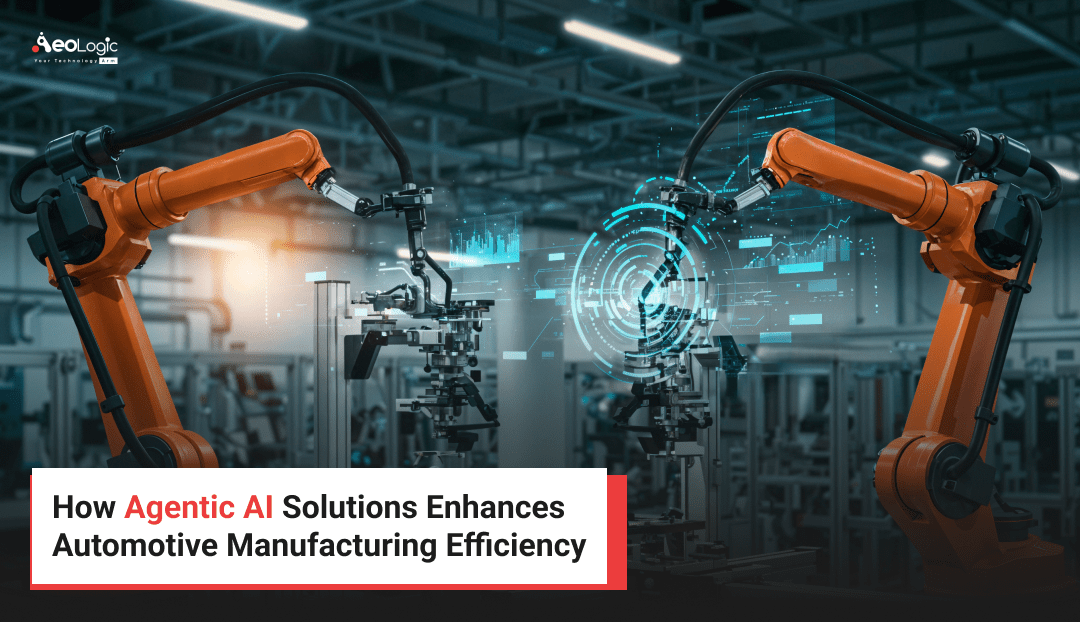Why Agentic AI Is a Big Deal Imagine walking into a car factory in 2030. You’d probably see more humans than robots—but those humans would be working with agentic AI solutions,, not just pushing buttons. That’s because automotive manufacturing is evolving from automation to autonomy, and agentic AI is the technology leading the charge.
So what distinguishes agentic AI from the old kind of automation? It’s the capacity to think and act like it’s going toward something, even when it gets off-script. That’s enormous in car manufacturing, where precision, velocity, and flexibility aren’t convenient to have—they’re mandatory.
What Is Agentic AI, Really?
The Simple Version:
Agentic AI solutions is similar to having a super-intelligent assistant on your production floor. But rather than waiting for directions, it anticipates, gets your objectives (such as making 1000 flawless cars per day), and optimizes on its own. It’s similar to having an employee who doesn’t wait for instructions, catches on quickly, and even improves each shift.
The Real Version:
Agentic AI solutions is a program that acts like an “agent”—it knows about goals, interprets context, decides, acts, and learns from outcomes. It’s not programmed to merely repeat steps. It acts autonomously and with intention, as if it has a mandate.
How Agentic AI Solutions Are Transforming Smart Electronics Manufacturing Call it what it is: producing electronics has never been so complicated.
You’re dealing with supply problems, demands for quicker cycle times, and end-customer expectations for defect-free boards. The tried and true approach—tough automation, standalone systems, and sluggish response times—is no longer sufficient.
Agentic AI solutions come in and turn the tables on you.
These systems don’t just respond. They act, anticipate, operate like a senior technician who knows the factory floor better than anyone—except this technician lives in every machine, works 24/7, and scales instantly.
Take a high-mix, low-volume product run, for example. The conventional setup would take hours—sometimes days—to calibrate. With agentic AI, the machines learn in real time. They change temperatures, speeds, and pick-place sequences according to micro-adjustments picked up during mid-cycle.
That ain’t “automation.” That’s intelligence.
And because these systems talk to each other, a hiccup on the stencil printer side can immediately trigger adjustments on the reflow oven or component feeder. All without waiting for human intervention.
We’re talking about truly smart manufacturing in action.
And here’s the deal: the more complex your operation, the more agentic AI shines. High-density boards? No problem. Constant model changes? Handled. Compliance logging? Instant.
Where Agentic AI Does Real Work
1. Predictive and Prescriptive Maintenance
Old way: A machine breaks down. Someone diagnoses the problem. Production grinds to a halt.
Agentic AI in action:
- Identifies temperature increase, vibration fluctuation, or unusual sounds.
- Predicts failure and replaces parts ahead of time.
- Redirects tasks so downtime from one machine doesn’t close the whole operation down.
Why it’s important: Plants experience 30–50% fewer shutdowns and bounce back from problems without skipping a beat.
2. Dynamic Workflow Reconfiguration
- Welding station bottleneck? Agentic AI diverts work to free robots, throttles upstream to pace output, and ramps it up elsewhere.
- Components shortage? The system substitutes compatible components if they have them, or alerts delivery crews to bump up restocking.
- It is important because this real-time choreography keeps the line running even when things go wrong.
3. Smarter Quality Assurance
- Computer vision inspects welds, paint layers, bolt torque—on every single car.
- If something’s slightly off, the system can isolate the car for rework instead of stopping the entire line.
- Each defect refines the AI’s detection logic, making future inspections sharper.
Outcome: defect rates drop by around 25–40%, and fixes happen faster.
4. Energy and Sustainability Management
Factories suck up energy. Agentic AI can:
- Dim lights based on aisle occupancy
- Adjust HVAC in real time
- Shift power loads to off-peak times
- Power down idle equipment automatically
- This adds up to 10–20% energy savings—beneficial for the environment and your bottom line.
5. Supply Chain Intelligence
Agentic AI doesn’t just monitor your factory—it monitors your supply chain:
- Tracks parts from suppliers through warehouse to assembly line.
- Monitors delivery times, vendor reliability, global shipping delays
- Adjusts production schedules ahead of time
- Switches to backup suppliers if necessary
That is, there are no longer unexpected line delays or last-minute shipping fees.
6. Human-Agent Teaming
- Last but not least: there is no replacement of humans by agentic AI.
- New employees can trace AR-guided instructions at their skill level.
- AI mentors assist employees in resolving issues faster.
- Humans train the AI through feedback every time it learns something.
The outcome? Safer workplaces, reduced burnout, smarter employees—with AI handling time-consuming heavy lifting.
The Real Metrics Behind Agentic AI
Let’s stop talking theory and get real with what companies are seeing in numbers:
KPI Before AI With Agentic AI
Unplanned Downtime ~20 hrs/month ↓ 6–10 hrs/month
Throughput Rate 60–70% ↑ 85–90%
Quality Defects per 10k Units ~120 ↓ 30–50
Human Errors 5–10% ↓ <2%
Energy Costs High, inconsistent ↓ 15–25%
Inventory Delays Weekly issues ↓ 80% of disruptions
Maintenance Costs Reactive Predictive = savings of ₹10–50L/year
Key takeaway: You don’t just improve one area—you lift the entire manufacturing ecosystem.
It’s not magic, it’s math. And it works because Agentic AI adapts on the fly to keep those KPIs optimized continuously.
Who’s Leading the Charge? (Real Case Studies)
1. BMW
BMW is using digital twins powered by agentic AI to simulate production tweaks in a virtual space before applying them on real lines. Imagine trying out 100 workflow options in a week—and only applying the best one. That’s what they do.
2. Tesla
Tesla is the classic “agentic AI everywhere” example. They use AI not just in the car, but to run the factories—robots dynamically adjust based on minor shifts in assembly timing. It’s not static programming; it’s fluid orchestration.
3. Toyota
Toyota’s new-generation plants use agentic AI for logistics management—deciding how to move parts in the most efficient way daily, based on everything from worker availability to supplier delays.
4. Volkswagen
VW created an “Industrial Cloud” connecting over 120 factories. Each one feeds real-time data to help others adapt. That’s cross-plant agentic learning.
5. Mahindra & Mahindra (India)
Mahindra is piloting agentic AI in their Pune plant to control energy usage and line balancing. They’ve seen an 18% boost in efficiency in under a year.
The Road Ahead – What’s Next?
Agentic AI isn’t done. It’s just starting to show its full potential. Here’s what’s on the horizon:
1. Self-Healing Systems
Machines will fix themselves. If a robotic arm gets misaligned, it’ll realign itself based on historical patterns—no waiting for a tech to come check it.
2. Factory-to-Factory Collaboration
Agentic AI will enable plants in India to talk to plants in Germany and Korea. If one hits a delay, the others adjust instantly. It’s like the global brain of manufacturing.
3. Real-Time Process Innovation
Instead of engineers testing changes for months, AI will simulate thousands of variations of a workflow in hours and tell you which ones will give the best ROI.
4. AI-Generated Workflows
You’ll feed a goal to the system like: “Reduce paint usage by 15% without reducing quality.” It will redesign the painting line on its own—and give you the blueprint.
5. True Zero-Defect Manufacturing
With precise sensor networks and continual feedback loops, the concept of defects will become obsolete.
6. Carbon-Aware Manufacturing
Agentic AI will optimize production timing based on carbon impact—e.g., delaying certain tasks until the power grid is cleanest (solar-rich hours), without affecting deadlines.
Implementation Challenges—and How to Overcome Them
Deploying agentic AI is not flip-a-switch easy. But these are problems your competitors are fixing:
1. Ancient Hardware
Ancient hardware doesn’t speak with new systems—but you can get them chatting with:
- IIoT gateways
- Edge computing modules
- Custom API adapters
2. Data Holes & Integrity
- Agentic systems need data:
- Fill holes with synthetic data from simulations
- Employ agents in a shadow mode for real-time learning
- Clean data pipelines on a continuous basis
3. Skillsets and Workforce Adoption
- Start with a technical team who gets it
- Upskill the broader workforce with AR, VR, gamification-based learning
- Simplify explaining benefits: less re-work, more enhanced job roles
4. Cybersecurity Threats
- More connectivity means more risk—but also more solutions.
- Zero-trust architectures
- Secure enclaves
- Real-time anomaly detection embedded within the AI
5. Organizational Transformation
- This isn’t a tech refresh—it’s a cultural transformation.
- Start small with pilot initiatives
- Celebrate early wins
- Scale deliberately
Conclusion – Why Agentic AI Is Non-Negotiable
Let’s be honest: agentic AI is not something you can just have. It’s needed. If you’re still considering automation, you’re already behind the times. Here’s what doing it – saying yes to agentic AI solutions – gets you:
- Faster uptime
- Increased throughput
- Improved quality
- Smarter, more productive employees
- Sustainable operations
- A competitive edge that can’t be outsourced
FAQs
1. Is Agentic AI going to replace workers?
No—and that’s not even the goal. It replaces repetitive decision-making and opens up time for humans to do higher-level tasks. Your workforce just becomes smarter and more efficient, not unemployed.
2. How do I convince leadership to invest in this?
Start with numbers. Show how a small-scale pilot—like predictive maintenance—can reduce breakdowns. Most execs don’t argue with ROI. Then build trust step by step.
3. We’ve already got automation—why do we need Agentic AI?
Automation executes. Agentic AI thinks. When conditions change (supplier delay, machine glitch), automation freezes. Agentic AI adapts. That’s a huge difference in fast-moving factories.
4. Is Agentic AI only for big players like Tesla or BMW?
Not at all. Indian mid-sized factories are using it for welding optimization, inventory predictions, and energy efficiency. Start small. You don’t need a billion-dollar setup to start winning.
5. What kind of tech stack do I need to implement this?
Start with:
- Sensors & IoT devices (for data)
- Cloud or Edge computing setup
- Agentic AI software platform
- Integrations with your ERP/MES
You can scale from there. It’s more about right strategy than right tech on Day 1.
6. How do I upskill my team to work with AI agents?
Use hands-on workshops, AR/VR training, and online modules. Let workers interact with the AI system during rollout. People fear what they don’t understand—so make it approachable and visible.
7. What if the AI makes a bad decision?
That’s what human override is for. Plus, most systems run in “shadow mode” first—where they observe and learn before being trusted to take action.
8. What does it cost to implement?
For small pilot projects, costs can be as low as ₹10–20 lakhs. Full-scale transformation may go up to a few crores depending on the plant size. But the ROI over 12–18 months is very real.
9. Will it work with old machines?
Yes, with add-ons like IIoT modules and edge devices. You don’t have to scrap your existing hardware. You just make it smarter with interfaces.
10. What if we start and fail?
That’s okay. Most successful factories fail fast, learn fast. The key is to start small—get a win, then move forward. Don’t aim for perfection. Aim for momentum.

Passionate about breaking down complex tech into simple ideas. Covers everything from AI and software development to gadgets and emerging tech trends.






